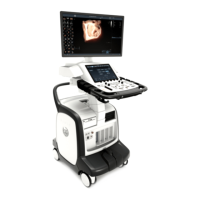Affects the transparency of the volume
rendering.
Too much 4D Gain applied will take away
structures, too little will leave opaque “Gray
clouds” in the ventricle
Edge preserving speckle and noise reduction
filter that reduces speckle while preserving or
even enhancing significant boundaries in the
volume data.
Increasing 4D Clarity will create images with
less visible speckle noise and with a softer
appearance.
Sets the cut-planes and crop planes to pre-
defined positions.
Use to display different rendering views –
can be used in 2d mode to angle through
different views without rotating the probe
Automatically optimizes the brightness of the 4D
image.
Use for quick optimization of image
brightness – further manual adjustments
may be required to suit individual
preferences.
Sets the cut-planes and crop planes to the
default position.
Performs temporal processing which reduces
random noise without affecting the motion of
significant tissue structures.
Reduce if there is too much smoothness in
the image.
Rarely (once
set to
desired level)
Adjusts the frames per second of the system –
adjusting means a trade of between spatial and
temporal resolution.
Use to avoid multibeat to get FR >13 for
LVQ – trade off with image resolution.
Adjusts the brightness of midtone values.
A higher gamma value produces an overall
darker image, a lower gamma value a
brighter image.
Simulates light propagation and scattering
through tissue
Use for rendered images with realistic
looking soft shadows.
Low velocity
reject (in 4D
Colour mode)
Removes low velocity blood flow and tissue
movement that reduces image quality.
Turn on during 4d colour acquisition to
improve
Adjusts the shading effect on the volume
rendering
Use to improve three dimensional
perception.
Affects continuity of structures and image noise
in the volume rendering.
Too much smoothness will blur the image,
too little will leave too much noise.
Translates the crop plane into the volume.
Adjust to move closer to structure of
interest and improve appearance of 4D
image.
Colour
Transparency
(4D colour)
Adjusts the display transparency of color data.
An increase of Color Transparency may help
bring out relevant color flow information
(e.g. jet).
Tissue
Transparency
(4D, 4D colour)
Adjusts the display transparency of tissue data.
An increase of Tissue Transparency may
help bring out tissue structures or flow
information behind obscuring tissue
structures.

